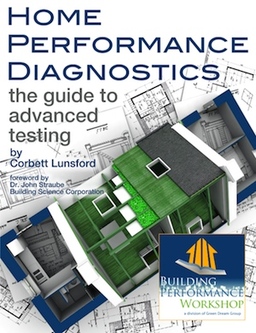RESOURCES
TechnicalHow Exactly to Conduct Scientific Testing and Verification for Homes. If you're a professional in today's fast-evolving industry of high performance construction and retrofits, then you've probably found yourself wondering a few things: Who can show me how to run that test? How do I get the most out of the equipment I own? Why do the tests work, and how do I explain them? What quality control methods should I use? Which tools will make my job faster and easier? With this guide, experienced and new diagnosticians alike will get step-by-step details on advanced testing, complete with best practices, important concepts and pitfalls, ways to present data to the client, Step-By-Step photographs, and time-saving tips, plus quiz questions for each diagnostic!
30-DAY RISK-FREE GUARANTEE If you aren't completely satisfied with this book within 30 days of purchase, we'll refund your money. BOOK REVIEWS: "The first book of its kind for the home performance industry. You ought to own this book." ~Don Hynek, Home Energy Magazine "So clear and direct. My own attempts to focus on testing have been cluttered by comparison." ~Jim Fitzgerald, Center for Energy and Environment "I highly recommend that everyone in the building performance industry buy a copy and use it!" ~Brett Dillon, IBS Advisors, RESNET Board of Directors "Notable not just for the range of procedures, but for the step-by-step clarity with which Corbett walks you through the procedures." ~Mike Rogers, OmStout Consulting GET YOUR COPY HERE! |
Blue Host Web HostingWeebly Drag & Drop Website BuilderWhile searching for an easy website builder, I found Weebly the simplest and most powerful to use. It is a drag and drop website builder with no software to install and it's simpler to use than a Wordpress or Dreamweaver. One of the main advantages we have as small business owners is the ability to respond quickly to what we learn from our customers and change things in our business that aren't converting. The nice thing about Weebly is that I don't have to go to a coder or marketing company every time I want to change the placement of a photo, post a new blog or add a product page. I can do it myself. Weebly has templates that make your design look good too, even for a non-web guy whose stick figures look like they are in some kind of pain. I've used it since 2009 and have found it is powerful enough for me to grow into as I've become more web savvy. It's free to use to build the site, see if you like it and then upgrade to a paid web address.
Heyo Landing PagesHeyo offers easy to use, lowest cost, drag and drop, Facebook landing pages. These are ideal for Facebook ads to keep your target prospects on Facebook which leads to more engagement and lead capture.
|



